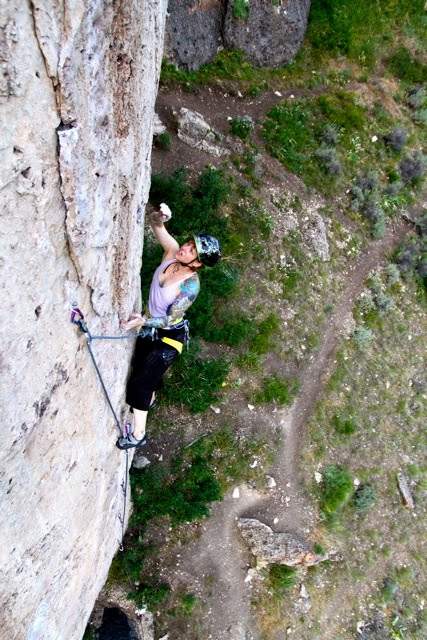Interview With Pro Route Setter Molly Beard: The gym’s route setting process often goes unnoticed, yet it is one of the most influential factors in competitions, indoor climbing, and gym culture. Earlier this summer, we talked with various female setters, which Missy coined “the unicorn of the climbing world” for their rarity. In today’s post, we aim to shed light on one of the “unicorns” behind this route-setting process. Molly Beard is arguably one of the most experienced and well-known setters, male or female.
Check out healthy weight loss tips with us, here!!!
Interview With Pro Route Setter Molly Beard
Climbing for 20 years and setting for 18, Molly stands out among the rest, not only as one of the few female setters at the national level, but especially for her creativity, vision, and commitment to doing the work she loves. In her setting and climbing philosophy, Molly has a heart for all climbers and a desire to set for the youngest as well as the oldest, the V0 and the V10 climber, the kid who can’t reach and the 6’4″ climber. Read on to examine climbing from the setter’s perspective, and learn more about the creative route-setting genius of Molly Beard. Molly Tensleep EKV
Molly Tensleep EKV
CXC: Your job seems very unique to us, especially for a female. What got you into route setting in the first place?
MB: I did some competing on my own and then began coaching a youth team in 1995. It was really obvious when the setting was good (as inequitable for tall or small, not bottlenecks, etc.) and when it was not. I got curious about how to set hard things that my tiny kids could reach, and so started to work on that concept by making routes for my team for practices.
Near this time Tony Yaniro was in Portland going to school, and he hosted a setting clinic at one of the gyms. I was too poor to be able to attend, but asked him if we could trade: I would set for him for free at an upcoming Youth Regional Championship if he would teach me. He agreed. I got completely worked, wrecked, and schooled, and after sleeping a few days, was beyond psyched to learn more. I am constantly and profoundly grateful that he agreed to mentor me.
CXC: What has it meant to be a full-time freelance route setter?
MB: It meant I had to learn how to promote myself, which was hard to do! I really do not like talking about myself – doing a good job is what is important, and should speak for itself. But that is not how the modern world works. It also meant that I had to be willing to take risks in order to find work. Cold-calling gyms for work is pretty intimidating, but I had to learn to not take ‘no’ personally. It is very interesting being the sole female in a job like mine.
I would very much have liked to see more women by now. It is utterly baffling and worrisome that I have not.

CXC: In terms of your creative process, how do you keep your setting style “fresh”?
MB: Keeping the setting fresh is such a great question. I look at my creativity as I would money resources. I certainly won’t spend all my savings at once. So I am not going to spend all my creativity at once. I spend a little here and a little there, but save most of it, accrue a bunch of interest, and spend a ton on a big championship! So for the day-to-day setting I focus a lot on what will make my members happy, and 80% of the time they want consistently forced moves, not too tweaky, and not too crazy.
CXC: At their inception, the purpose of climbing gyms and indoor routes was to train for and mimic climbing outside. As the sport has progressed indoor climbing has strayed from its original purpose and in some critics’ opinions has become a platform for showing off the wacky movement by the competitors. While this type of climbing is impressive to watch it may be widening the divide between indoor and outdoor climbing. What do you think this means for the future of climbing, both indoors and out and what are your thoughts on the direction and expectations of competition climbing?
MB: I do not see this as a problem. If you look at climbing worldwide, gym climbing has already become an activity unto itself. Think about places where there is none-to-little outdoor climbing. Of course, gym climbing becomes appealing. While I love to see what might be ‘new’ my ultimate goal is results. Ties suck. Bottlenecks suck. Shutting down an unusually small kid REALLY sucks.
When I see these things I wince. When I am responsible for them I get angry. That said, I think comp climbing has begun to hit the end of creativity with the current tools we have. I don’t really look at this as good or bad: it just is. It means that the tools we use will likely evolve further as people want to see more unusual things in comps, and I look forward to what that might look like! I’ll say it another way: cool moves are cool, but not at the cost of results.
CXC: Do you see the divide between indoor and outdoor climbing as detrimental to the sport?
MB: I think more climbers, no matter where they climb, is a good thing. The more people who understand what climbing is, the better it is for the growth of the sport, the better our chances of someday becoming an Olympic sport, and frankly the better for the preservation of the outdoor resources. Gym climbers write letters to their representatives too!
The place where a divide could be bad is when some of the gym climbers begin to transition to the outside. They often have no mentors to teach them etiquette, basic manners, or just good crag-care. These behaviors can range from annoying to scary. I love those gyms that purposefully help folks make a good transition and shake my head at those that purposefully do not.

Photo by L Cujes 2010
CXC: At the end of the day you’re setting not only for yourself but for the climbing community and for your client. Have you ever been in a situation where you had to compromise your creative vision for your client? How have you dealt with differences in vision?
MB: Compromise is something every setter should do for safety reasons. It is something every setter should do with discussion with their crew, Chief or Head Setter, as even good setters will sometimes set a stinker! With member feedback I always go back to my knowledge about them, are they complaining because the route requires lock-offs and they don’t like them? “Bummer dude, there are another 70-200 routes in the gym to climb.” Sarcasm aside, you WILL NOT please every climber 100%, 100% of the time.
You need to please 80%, 80% of the time, minimum. Base your setting decisions on these numbers, and not on a squeaky wheel! When differences arise, communication is always key. What, precisely, is the person upset about? Can they articulate why? If not, can you, kindly, help them say it clearly? Often just talking with an upset member can do wonders. Ahold might have spun or a piece of tape might have fallen off, and hey! Presto! Problem solved. Sometimes it is just talking them through a new technique.
There is really no reason to ever pull a “bummer dude”, no matter how much you might want to.
CXC: What has kept you coming back to set for 18 years?
MB: That there is ALWAYS something more to learn. That never gets old. And the kids. These amazing, wonderful kids! For me, it has always been primarily about the kids, especially the littlest ones. To work an event and build fair routes and watch the kids of all sizes climb exactly how the route was meant to be climbed… is pretty much what drives me from event to event.
Thank you so much to Molly for sharing her insights with us. For more from Molly check out additional questions here.






